


Schweizer 1-26 Sailplane
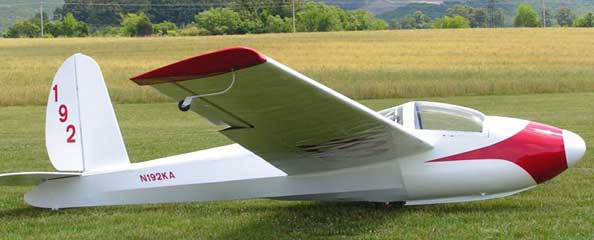
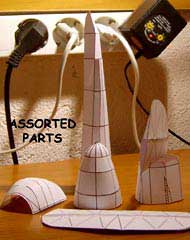
The Schweizer 1-26 is a single-seat, mid-wing glider
that is popular for casual and non-aerobatic flights, used in
civilian and military environments, built by Schweizer Aircraft.
The SGS 1-26 is very popular and numerous sailplane in the United
States with a very long production run from its first flight in
1956 to circa 1981. Early 1-26s were offered both in kit and pre-assembled
form, although this practice was ended with the E model. The 1-26
is used by many soaring clubs in the United States, and is often
the first single place glider that a student flies immediately
after soloing, often coming from a Schweizer 2-33 two-seat trainer.
The 1-26 is supported by an active aircraft type club, the 1-26
Association, which organizes competitions around the one design
1-26 class.
Awesome glider Chip! Modee Johnson
Thanks for providing the 1-26 glider. Would like to have the 2-33 and ASW 20 gliders before my paid time runs out. I am mostly interested in light aircraft and gliders. Mike
Love the Schweizer ! All the best, Peter Henderson
Crashed it 20 times. All it took was a little bit of glue and it was back in the air - Jim
Scweizer SGS 1-26
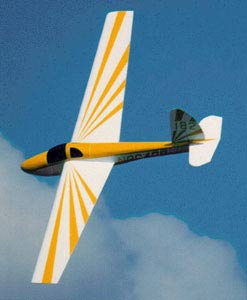
by
Paul A. Schweizer
[Reprinted from the 1-26 Association Newsletter]
It's hard to tell just when we got the idea of a one design sailplane. The seed could have been sown in the middle 20's when the editor of a boating magazine had a flat tire by our home in Peekskill, New York. Joe Heimer, my father's handy man, fixed the tire but refused payment. Instead, the editor sent him a subscription to his boating magazine. Since Joe had no interest in boating, he turned the magazine over to us boys: Ernie, Bill, and me. This got us interested in boating and sailing and we started going to the annual New York Boat Show where we were attracted to the sleek sailboats and where we learned about the one- design concept.
Our sailing activity came to an end when Lindbergh flew to Paris
and we switched our interest to flying. We built model airplanes
for two years and, then, when we saw the June 1929 issue of the
National Geographic with its famous article on Soaring in Germ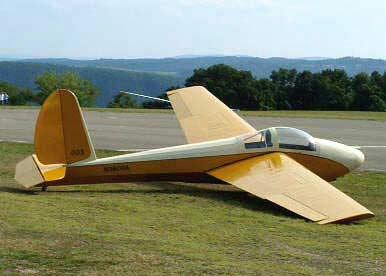 any,
we became interested in gliders and sailplanes.
any,
we became interested in gliders and sailplanes.
During the latter part of World War II, we were looking forward to what type of sailplanes we might build once the war had ended. The idea of a one-design class sailplane occasionally surfaced and, when Ben Shupack and Gus Raspet requested a paper for the SSA Technical Soaring Conference at Brooklyn Poly, I agreed to write a paper about the one-design concept. In order to get more information on one design sailboats and sailing, I contacted the editor of Yachting magazine and the manager of the Skaneateles Boating Company that was producing a popular one-design sailboat.
The paper was presented at the Conference and was printed in the November-December 1944 issue of 'SOARING' and was title"Adapting the One-Design Class to Gliding and Soaring." In the same issue an article by Parker Leonard projected a possible one design class sailplane called the Sailfly which, incidentally, looked somewhat like the 1-26 would look, but had a span of 46 feet and was to be made of wood.
Once the war had ended we concentrated
on building trainers which we felt were needed first to get the
soaring movement going again. When National Contests started again
in, 1946, interest in a high-performance competition sailplane
developed. Ernie designed the 1-21 and Dick Comey won the 1947
National Soaring Championship in the prototype a few weeks after
it was completed.
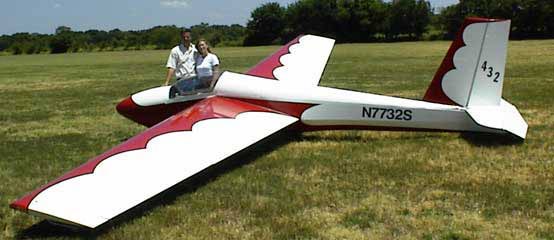
The 1-21 was a fine sailplane but at $3500 it was too expensive and we only sold two of them. We then developed the 1-23 which was smaller, simpler, and lower in price and this ship proved to be more popular. After selling about twenty-five of these over the next few years the sales dropped off primarily because of price.
We realized that a lower priced sailplane was desirable but that it would be difficult to make any large reduction in cost over the 1-23 standard, so Ernie up with a new design that would be suitable for home building from a kit. We reasoned that to be successful the kit should be able to be completed in less than a year's time, that all parts and material should be supplied, and that critical structure should be factory assembled.
Through the use of questionnaires we learned that the majority wanted a small, easy to fly sailplane with Gold "C" potential in a kit that cost $1000 and as a complete ship at $1500. We made a lot of design and cost studies and we finally came up with the 1-26. The best we could do in price, however, was a basic kit for $1465 and a complete ship for $2150. These prices assumed that we would have good sailplane and steady production. Sufficient interest was shown to warrant going ahead and building the prototype in the Fall of 1953. It was completed on January 16, 1954, and I had the honor of making the first flight.
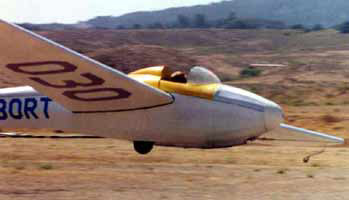
The history of the 1-26 from that point is pretty well known. We produced 700 (including 200 kits) of four versions: the 1-26, 1-26B, 1-26D, and 1-26E. Our theory on the kits was correct for every one sold was completed and certified and many were built in less than a year. One-design competitions became popular and started with the first Regatta in 1955. The 1-26 Association was formed and the Annual 1-26 Championships has become a very competitive contest.
We decided to stop production of the 1-26 in 1979 at ship 700. The increased cost of production and the reduced number of sales made it uneconomical to continue. Some felt that this would be the end of the 1- 26 movement. This was not the case for the 1-26 continues to offer top competition in an affordable sailplane. New sailplane prices are escalating (there are no new sailplanes much under $20,000) and other used sailplane prices are in the $10,000 to $20,000 range. Alternatively, used 1-26s are usually under $10,000 and are an excellent buy for those that want fun and competition at low cost.
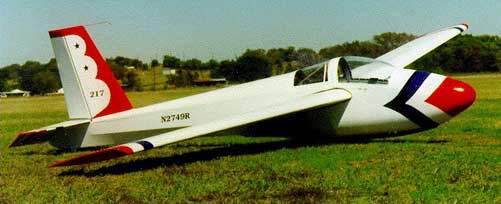 |
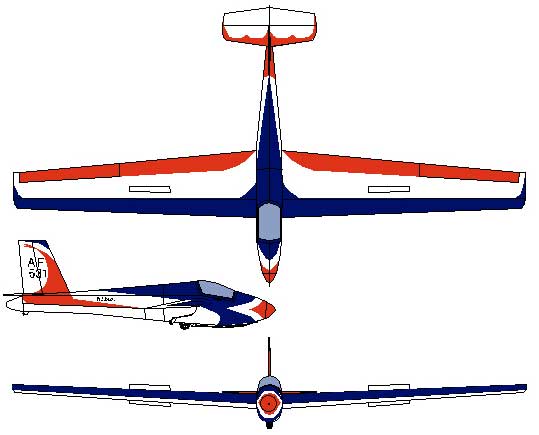 Note the difference in the vertical tail in this later model. |
It would appear that competition will develop between those who
want to get a 1-26 for one-design competition, and the clubs and
commercial operators who find it an excellent sailplane for building
up experience. This will put pressure on price and make the 1-26
an even better investment if prices continue to rise. If a shortage
of 1-26's developed, it might justify production in a foreign
country where costs are lower. The membership in the 1-26 Association
is at an all time high. With over 600 1-26s in the country the
1-26 Association has room to grow. 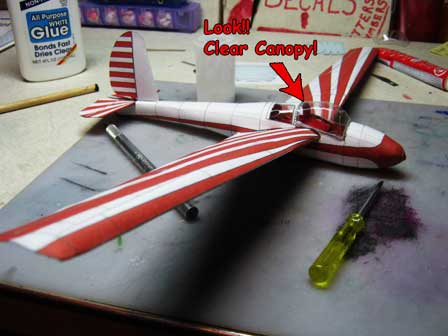
There are some who feel as I do that there is more "status" to doing a good job of flying in a 1-26 one-design competition than flying aimlessly about in a much higher performance sailplane. It is excellent training for those who later may want to move ahead to a higher performance sailplane. I foresee the 1-26 Association continuing to grow as a class and that it will encourage other new one-design classes to form. There are benefits to all 1-26 enthusiasts to have a stronger 1-26 Association-- it will be more fun and more satisfying for all members.
The Schweizer 1-26 was manufactured by the Schweizer Aircraft Corp at Elmira, New York and can land easily in a small field then loaded onto a trailer in less than 30 minutes. The 1-26 is rugged, inexpensive, durable, and easy to fly making it (arguably), the most popular sailplane in America. Pilot Jim Hard flew his 1-26 413 miles in 1990. In doing so, he traveled across 5 states-Minnesota to Indiana.
The Schweizer 1-26 is a single-seat, medium performance sailplane used for cross-country and spin training. The 1-26 allows students to master basic flight maneuvers while solo before progressing from the TG-4A basic trainer to the more advanced TG-9A sailplane.
The 1-26 features spoilers and a mid-wing configuration. Equipment includes basic flight instrumentation, an M-NAV soaring flight computer, and an oxygen system complete with intercom for high-altitude flights.
The USAF Academy has been flying this type of aircraft since the 1960's when only a soaring "club" existed. The first 1-26 was flown on 16 January 1954 by Paul Schweizer. A total of 700 1-26 aircraft were produced.
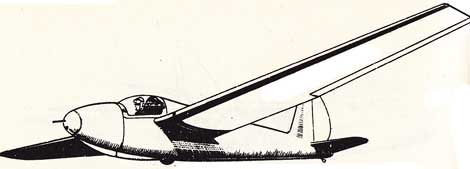
The Schweizer 1-26 beta version |
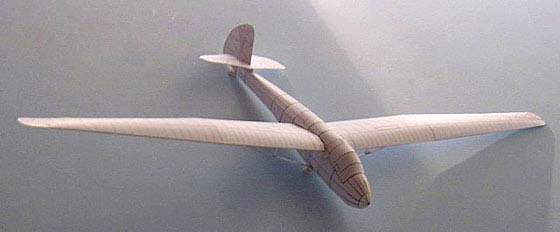 |
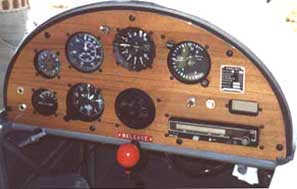 |
| Cockpit of the Schweizer 1-26. |
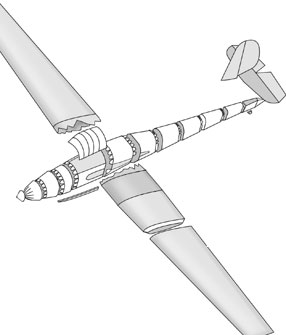 |
The
assembly details of the Schweizer SGS 1-26 sailplane. |
Specifications for the Schweizer SGS 1-26
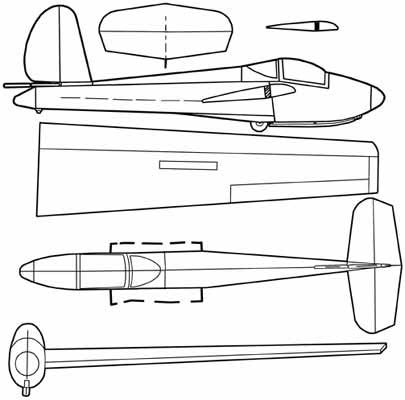 |
Length: 21 ft 6 in Wingspan: 40 ft Height: 7 ft 2 in Wing area: 160 ft² Aspect ratio: 10 Wing profile: NACA 4301 2A Empty weight: 445 lb Gross weight: 700 lb Performance Maximum speed: 114 mph Maximum glide ratio: 23 at 53 mph Rate of sink: 174 ft/min |


